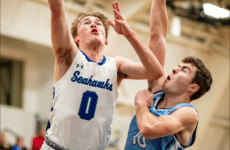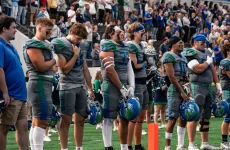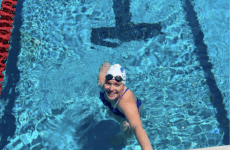By: Neva Bostic | Staff Writer
To our outside ears, eight hour practices sound unnecessary and brutal, especially for a team that is months removed from being in-season. This is what the Salve Regina Baseball team has faced as they welcomed the 2019-2020 team onto campus this fall, kicking off their fall season in early September.
However, these eight hours are strategically planned out to avoid breaking rigid NCAA rules while also benefiting the players. Salve Baseball’s Head Coach Eric Cirella, who has been at the helm of the program since 2013, was kind enough to offer some insight into what goes on during the team’s fall season.
He explained that they can essentially have four weeks of practice for a total of 16 practices in a fall season, and that it is necessary to plan these out in an effective way. “What has worked since I’ve been here, and we have won a lot of games and championships, is to try and put our system in place the first week, so typically the first practice is super long.” says Cirella.
He explains that the first couple of practices in particular are so long because they are jammed with team information about how they play, what they do, and how they do it, not to mention teaching and developing each player at their respective positions.
Cirella also gave a different perspective on his reasoning of long practices, saying, “Let’s say, hypothetically, we have a double-header in the spring on a Saturday. The game starts at noon, which means batting practice starts at 10 A.M. so the team should be stretching and setting up the field around 9. So, just from looking at this scenario, if we are going from 9 A.M. -noon, probably starting our second game around 3 wrapping everything up around 5:30, right there that’s 8 and a half hours.”
The point of practicing is to prepare for the future, and these practices accomplish exactly that. Coach Cirella also mentioned that these long practices mentally prepare the players for the fall by teaching them when the right time to concentrate is, because they can’t maintain hard focus for hours straight.
“That’s the importance of baseball,” said Cirella. “Teaching them how to train their brains to focus for 3 seconds of a pitch or play, then going back into soft focus.”
It is an NCAA Division III baseball rule that teams can only play one day of the fall season for a maximum of two nine-inning games. It is because of this rule that they were only able to play outside competition once this fall. However, the team is able to play intrasquad games (team scrimmages) in order to help prepare players for the spring.
Even though Coach Cirella said he would rather play outside teams, he also said there is still an advantage to intrasquad play. “The benefit of intrasquading for us is that our roster is a bit bigger in the fall, so we have enough people to form two teams and we can play each other so everyone participates, ” said Cirella. “Instead of just playing one pitcher, we can play two”.
With nearly 60 athletes showing up to the first fall ball practice and only a dozen coaches, Cirella explained that instead of playing a game and having everyone sit around, he likes to keep everyone doing something and participating. Whether it’s during intrasquad play or working in different groups like pitchers and position players, players are continually being developed and evaluated.
“Our system allows them to play so we can evaluate them and let them compete because it is a lot easier to win a spot on the field in the fall than it is in the gym in January.” says Cirella.
Behind these rumors is a strategic and well thought plan to get the most production out of a short fall season, which many programs view as an important building point for the regular season. Salve Baseball, perhaps because of this fall preparation, has experienced much success throughout its history. While Coach Cirella mentions some of this success stemming from luck with the elements of not enduring injuries to important players, much of the success undoubtedly comes from his approach to the fall season.
After seven straight seasons of at least 25 wins and three CCC titles (2015, 2016, and 2019), the Seahawks are looking to add to the program’s recent successes. Coming off last season’s 28-18 championship team from which they graduated eight seniors, it is clear that Coach Cirella has high hopes for what he called “a young group”.
When I asked him if this month of fall ball resembled another contending team, he said, “I think we are a better team than we were last year, who was a team that won 28 games and a conference championship, but that doesn’t guarantee anything. The Red Sox won a World Championship then didn’t even make playoffs the next year, you just don’t know. We can be as good as the players want to be, but the players have to want it too.”














